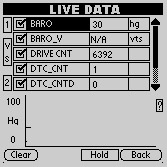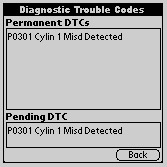The CJ-II from Automobile Electronic Services is a Palm and Visor compatible module for reading OBD-2 automobile diagnostic codes and monitoring engine status.
All new vehicles sold in the United States after 1996 have been required to use a standard diagnostic interface called "On Board Diagnostics-2" or OBD-2. Typically tools capable of reading these codes have either been expensive, or had very limited capabilities. Simple OBD-2 tools that only read trouble codes are commonly available at auto parts stores and are fairly inexpensive. However, these models are usually limited to providing a numeric "diagnostic trouble code" (DCT). Also, these cheaper units typically only work with a single make of car. So if you have a Ford and a Honda, you would need to purchase separate code readers.

On the higher end there are expensive machines designed to provide DCT's for a wide variety of car makes and models. These devices are designed for auto repair shops and offer features such as real-time status of engine RPM, car speed and engine temperature. Some also permit the resetting of engine trouble codes and even limited control over engine functions.
The CJ-II replicates most of the functions previously only available in these expensive dedicated automobile diagnostic machines.

Features
Tests were performed using the Visor version of the CJ-II, which includes a serial interface cable and the CJ-II interface module. There are different interface cables available for different PDA models. Currently, interface cables are available for the Palm m100, m105, Palm III series, Palm V series, and Palm VII series. For Handspring models, cables are available for the Visor, Visor Deluxe, Visor Platinum, and Visor Prism.
The CJ-II interface plugs into the OBD-2 interface port of 1996+ cars. Typically the OBD-2 port is under the dash, either passenger or driver side. The location of mine was not mentioned in the owner's manual of my car, but a quick look under the passenger dash area located it. The port is quite large and should be fairly obvious on most cars.
The software component of the CJ-II is included on a 3.5 inch diskette. The software installation was very simple, consisting of a single .prc file that needs to be HotSynced to the PDA. After the initial configuration of the software, there are five main options available.
The DCT screen allows reading of diagnostic trouble codes. These codes are usually only produced when the "check engine" light comes on.
The Live Data screen allows evaluation of real-time engine data. You can use the CJ-II to check engine RPM, vehicle speed and engine temperature, all in real time. The information can be displayed in either a graph or large format numbers. This is a very compelling feature for monitoring car performance. It would be a perfect tool for those tuning their cars for additional performance. Unfortunately, the current version does not allow for any recording of this data. Once you leave the live-data screen, the information is gone for good.
The Freeze Frame Data provides a snapshot of engine information stored by the vehicle at the moment a DCT was set. This is a valuable diagnostic tool that provides data such as engine temperature, vehicle speed, and RPMs at the moment of the DCT.
The Clear Memory function will clear all active Diagnostic trouble codes in the vehicle, basically turning off the check-engine light until another problem occurs.
Readiness Status displays system monitors typically associated with emissions control. The monitors include things like misfire, oxygen sensors, fuel, and the EGR system.
Evaluation
We were pleasantly surprised by the large feature set included in the CJ-II. For those who diagnose and repair cars, the ability to read diagnostic codes from a wide variety of vehicles is a must. The CJ-II performs that task well. However, although only shade-tree mechanics and performance tuners, we were still especially impressed with the ability to monitor live data in real time. This feature alone would be worth the price of the module if the ability to save data were present. As we mentioned, the CJ-II allows reliable testing of performance additions. It could be a very useful tool for those who drag race, autocross, or track their cars. In speaking with the manufacturer, they said data recording is a planned upgrade, but there was no timeline as to when it would be available.
The CJ-II is a quality product that does its job very well. At US$329 the CJ-II is priced very reasonably for those who have a professional need to troubleshoot automobile diagnostics. But without data recording capability, it's probably a bit too expensive for the hobbyist mechanic or weekend racer. -
-Kermit Woodall and Michael Vunck
Automobile Electronic Services
3849 N. Fine Avenue, #102
Fresno, CA 93727
Tel: (559) 292-7851
Fax: (559) 292-7851
www.aeswave.com
Back to Palm Section

